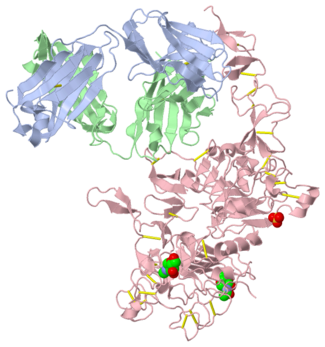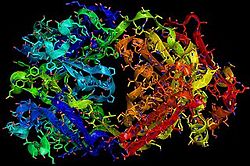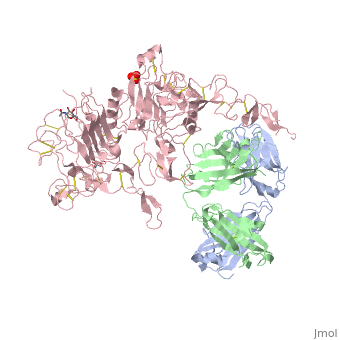Herceptin - Mechanism of Action
From Proteopedia
| Line 23: | Line 23: | ||
The HER family is composed of three domains: an <scene name='Sandbox_reserved_Herceptin/Extracellular_domain/1'>extracellular domain</scene> further divided into four sub-domains composed of about 630 amino acids, a <scene name='Sandbox_reserved_Herceptin/Transmembrane_domain/1'>transmembrane domain</scene> composed of a single membrane-spanning region, and an <scene name='Sandbox_reserved_Herceptin/Intracellular_domain/1'>intracellular domain</scene> composed of a tyrosine kinase. The four sub-domains of the extracellular region include: | The HER family is composed of three domains: an <scene name='Sandbox_reserved_Herceptin/Extracellular_domain/1'>extracellular domain</scene> further divided into four sub-domains composed of about 630 amino acids, a <scene name='Sandbox_reserved_Herceptin/Transmembrane_domain/1'>transmembrane domain</scene> composed of a single membrane-spanning region, and an <scene name='Sandbox_reserved_Herceptin/Intracellular_domain/1'>intracellular domain</scene> composed of a tyrosine kinase. The four sub-domains of the extracellular region include: | ||
| - | *sub-domain I | + | *<scene name='Sandbox_reserved_Herceptin/Sub-domain_i/1'>sub-domain I</scene> |
| - | *sub-domain II | + | *<scene name='Sandbox_reserved_Herceptin/Sub-domain_ii/2'>sub-domain II</scene> |
| - | *sub-domain III | + | *<scene name='Sandbox_reserved_Herceptin/Sub-domain_iii/2'>sub-domain III</scene> |
| - | *sub-domain IV | + | *<scene name='Sandbox_reserved_Herceptin/Sub-domain_iv/2'>sub-domain IV</scene> |
In EGFR, HER3, and HER4 sub-domains I and III remain in a “closed” conformation until a ligand binds. Sub-domain II remains hidden making contact with sub-domain IV. The interaction between sub-domain II and IV can be temporarily broken in order for the receptor to become available for a ligand to bind. Although unsure, evidence suggests that the ligand binds to sub-domain III and/or sub-domain IV; also, there’s some evidence of ligand-binding to sub-domain I. Once ligand-binding is initiated, the receptor experiences a conformational change allowing sub-domains I and III to become in contact resulting in the “open” conformation. This open conformation exposes sub-domain II which allows for dimerization between receptors. Although some evidence suggests that sub-domain IV is necessary for ligand-binding, stabilizing the extracellular domain, and locking the receptor in an open conformation, the exact function is still unknown. Once the dimerization between two receptor tyrosine kinases takes place, a cross-phosphorylation reaction occurs following the activation of certain cell signaling pathways. These pathways include: | In EGFR, HER3, and HER4 sub-domains I and III remain in a “closed” conformation until a ligand binds. Sub-domain II remains hidden making contact with sub-domain IV. The interaction between sub-domain II and IV can be temporarily broken in order for the receptor to become available for a ligand to bind. Although unsure, evidence suggests that the ligand binds to sub-domain III and/or sub-domain IV; also, there’s some evidence of ligand-binding to sub-domain I. Once ligand-binding is initiated, the receptor experiences a conformational change allowing sub-domains I and III to become in contact resulting in the “open” conformation. This open conformation exposes sub-domain II which allows for dimerization between receptors. Although some evidence suggests that sub-domain IV is necessary for ligand-binding, stabilizing the extracellular domain, and locking the receptor in an open conformation, the exact function is still unknown. Once the dimerization between two receptor tyrosine kinases takes place, a cross-phosphorylation reaction occurs following the activation of certain cell signaling pathways. These pathways include: | ||
Revision as of 04:10, 8 November 2012

Basics
Introduction
Breast cancer is the most common type of cancer found among women. Although it is rarely seen in men, one in eight women will be diagnosed with breast cancer within their lifetime. Patients exhibiting an over-expression in Human Epidermal Growth Factor Receptor 2 (HER2) account for 25% of all breast cancer. HER2+ patients often experience a more aggressive cancer resulting in more metastasized tumors. The statistics show a poor prognosis for HER2+ patients with a 5-year survival rate of 68%. Herceptin (also known as trastuzumab) was approved by the FDA in September of 1998 for HER2+ patients and has been shown to be an effective tool in the battle against breast cancer.
HER2
HER2 is one of four human epidermal growth factor receptors (EGFR , HER2, HER3, and HER4). These receptors are part of a family of receptor tyrosine kinases responsible for cell proliferation and differentiation.These human epidermal growth factor receptors exist on the cell surface and, with the exception of HER2, bind to specific ligands (epidermal growth factors). Over 11 different ligands for the Epidermal Growth Factor Receptors have been identified. After binding with these ligands the receptor tyrosine kinases are able to homo-dimerise (with the exception of HER2) or hetero-dimerise with one another. This dimerization causes a cross-phosphorylation between the two receptors and ultimately activates a cell signaling pathway causing cell division.
HER2 is the only receptor within this family that is constitutively active being able to dimerise with other receptor tyrosine kinases acting in a ligand-independent manner. This continuous activation of the cell signal pathway causes an increase in cell division; thus, potentially causing a tumor.
Herceptin
Herceptin, generic trastuzumab, is a monoclonal antibody. Herceptin is an effective treatment for breast cancer for the reason that it binds to the extracellular domain of HER2 and, by multiple mechanisms of action, can prevent cell proliferation as well as target these HER2+ cells for destruction by the immune system. By these mechanisms Herceptin is an effective treatment for breast cancer.
| |||||||||||



